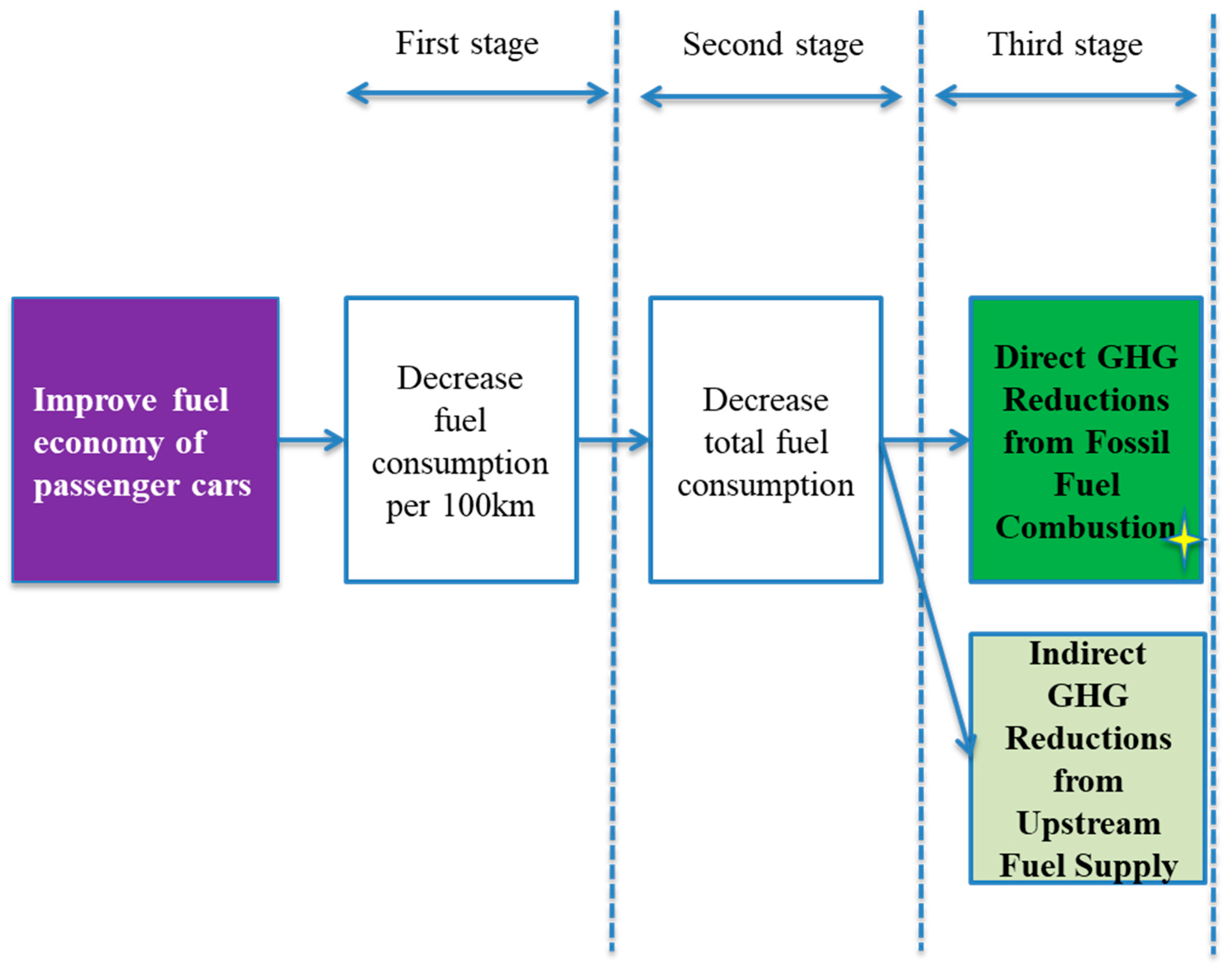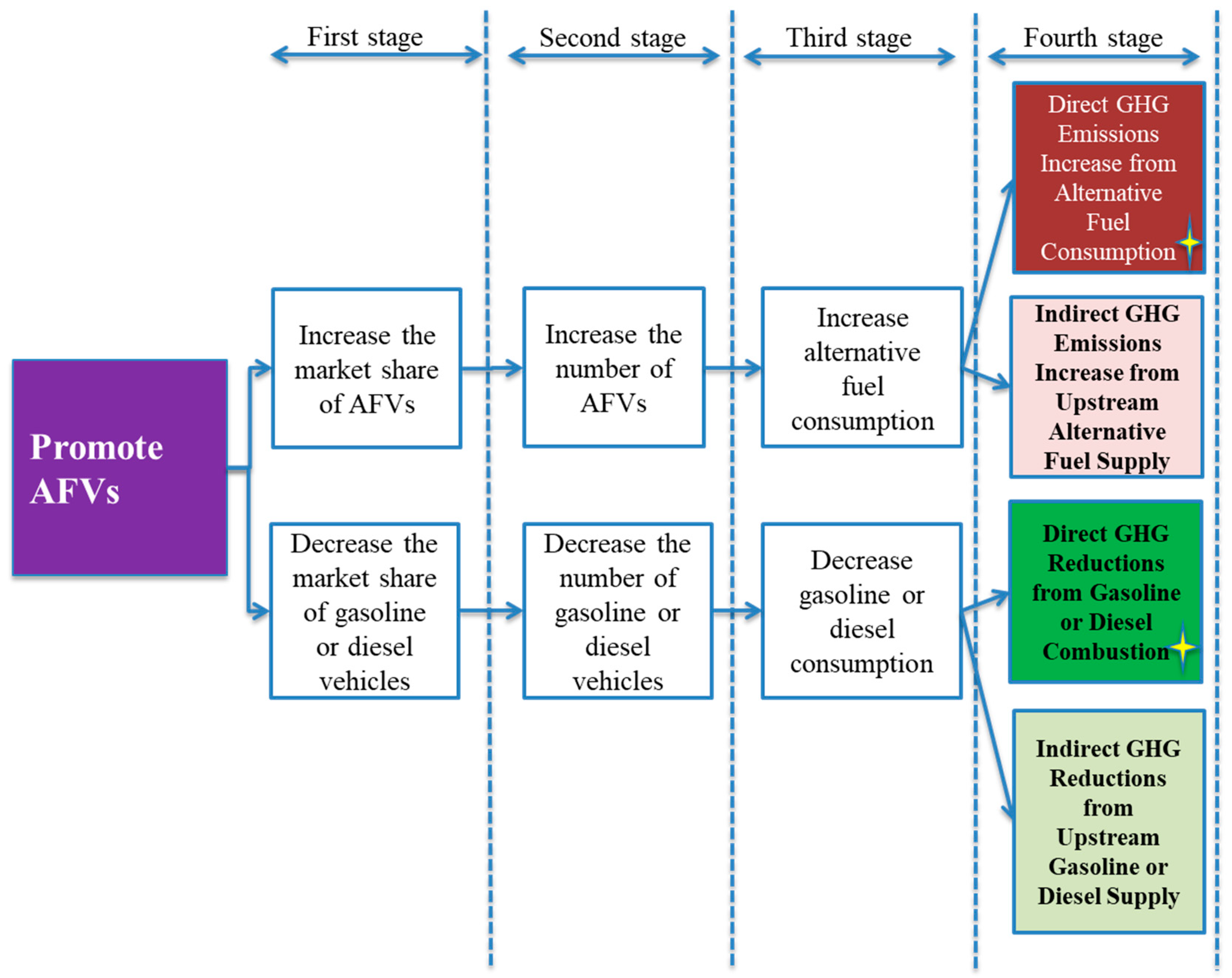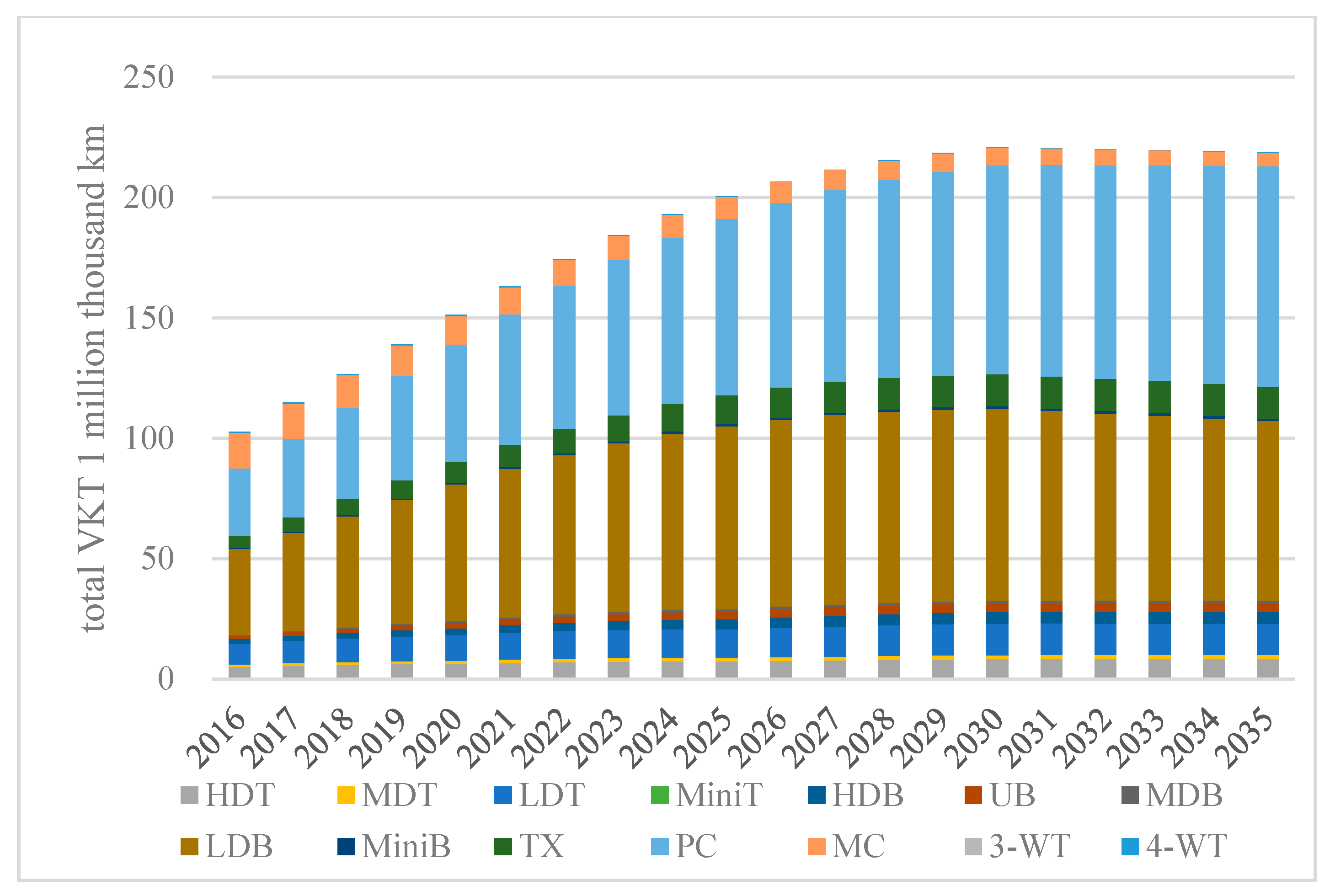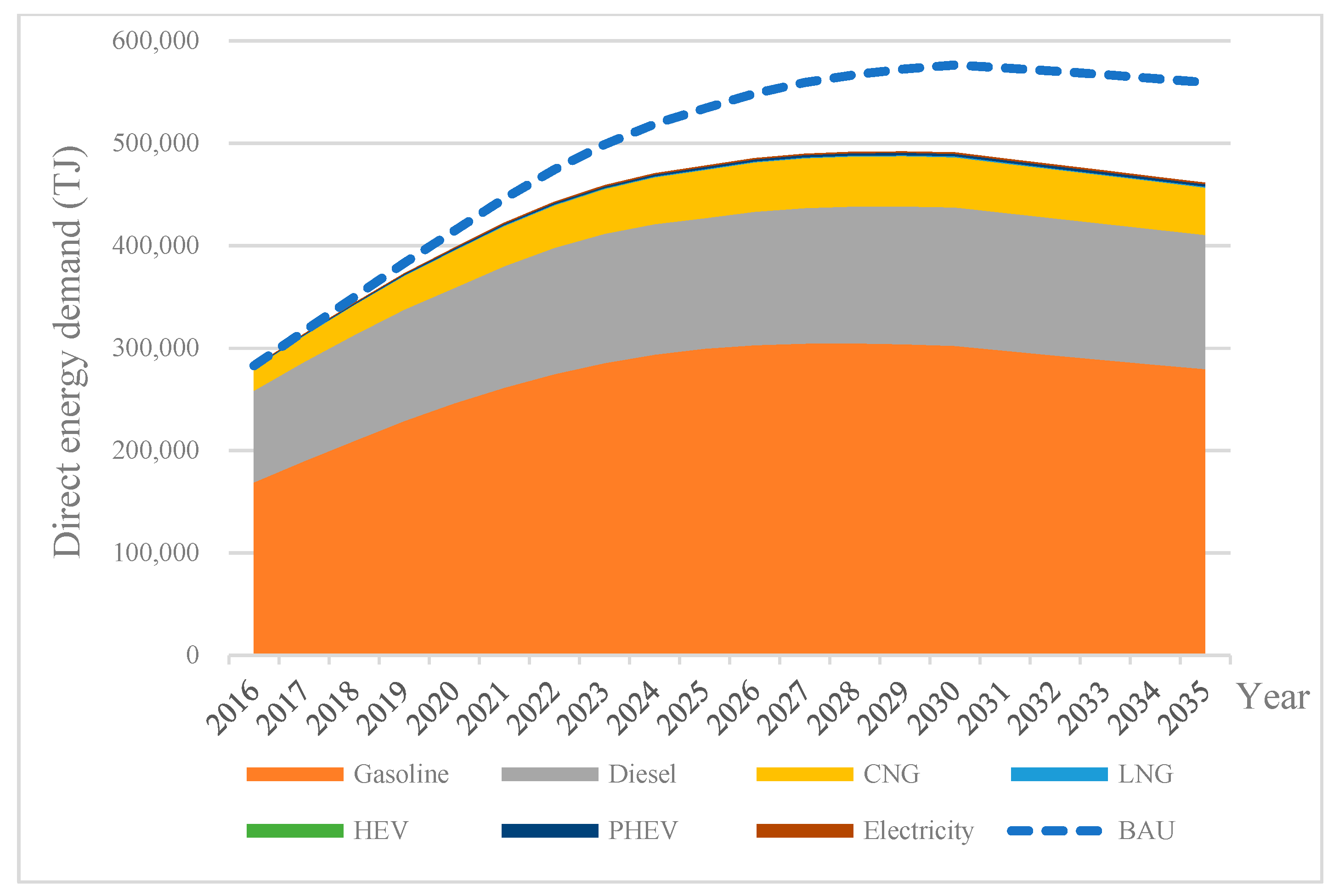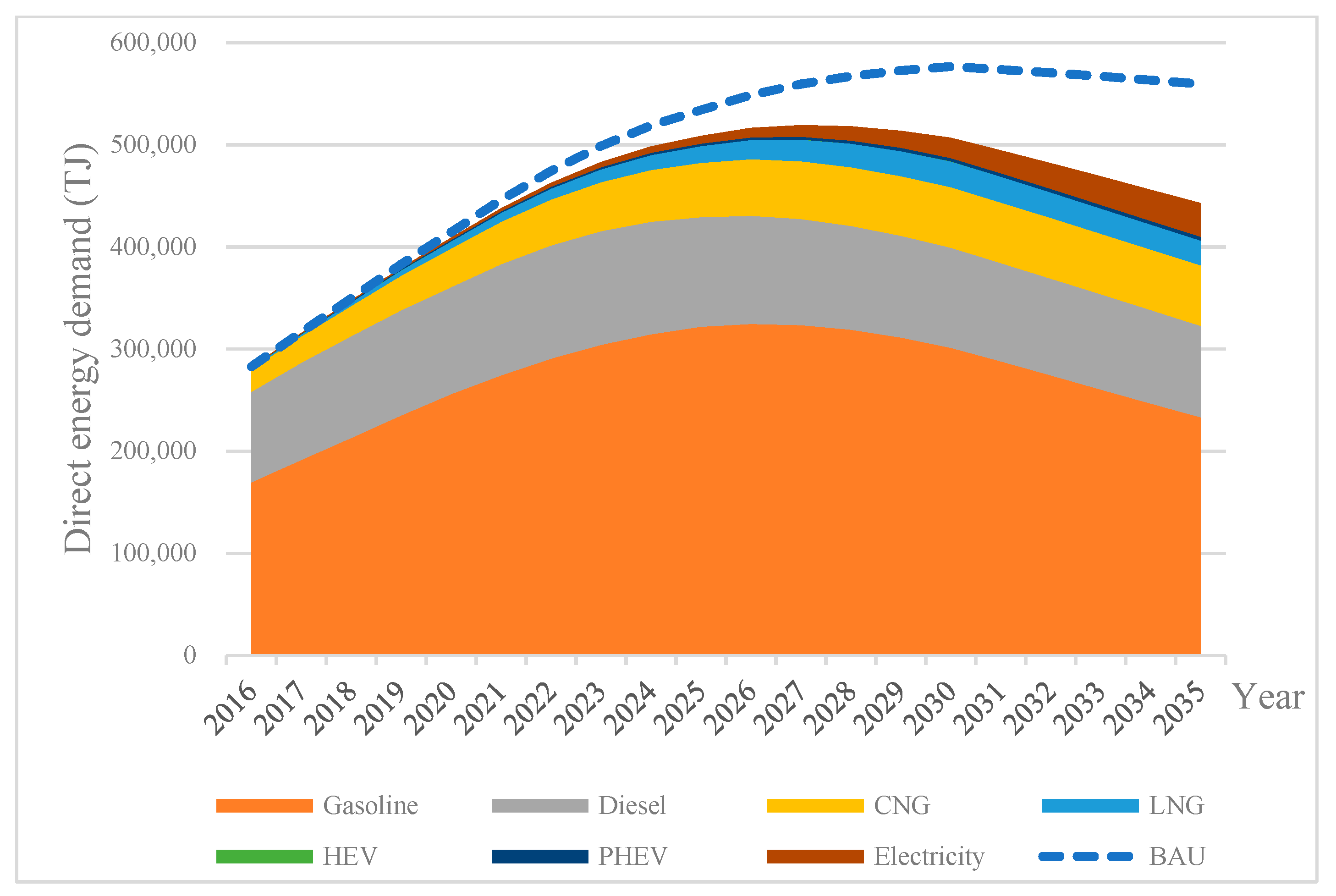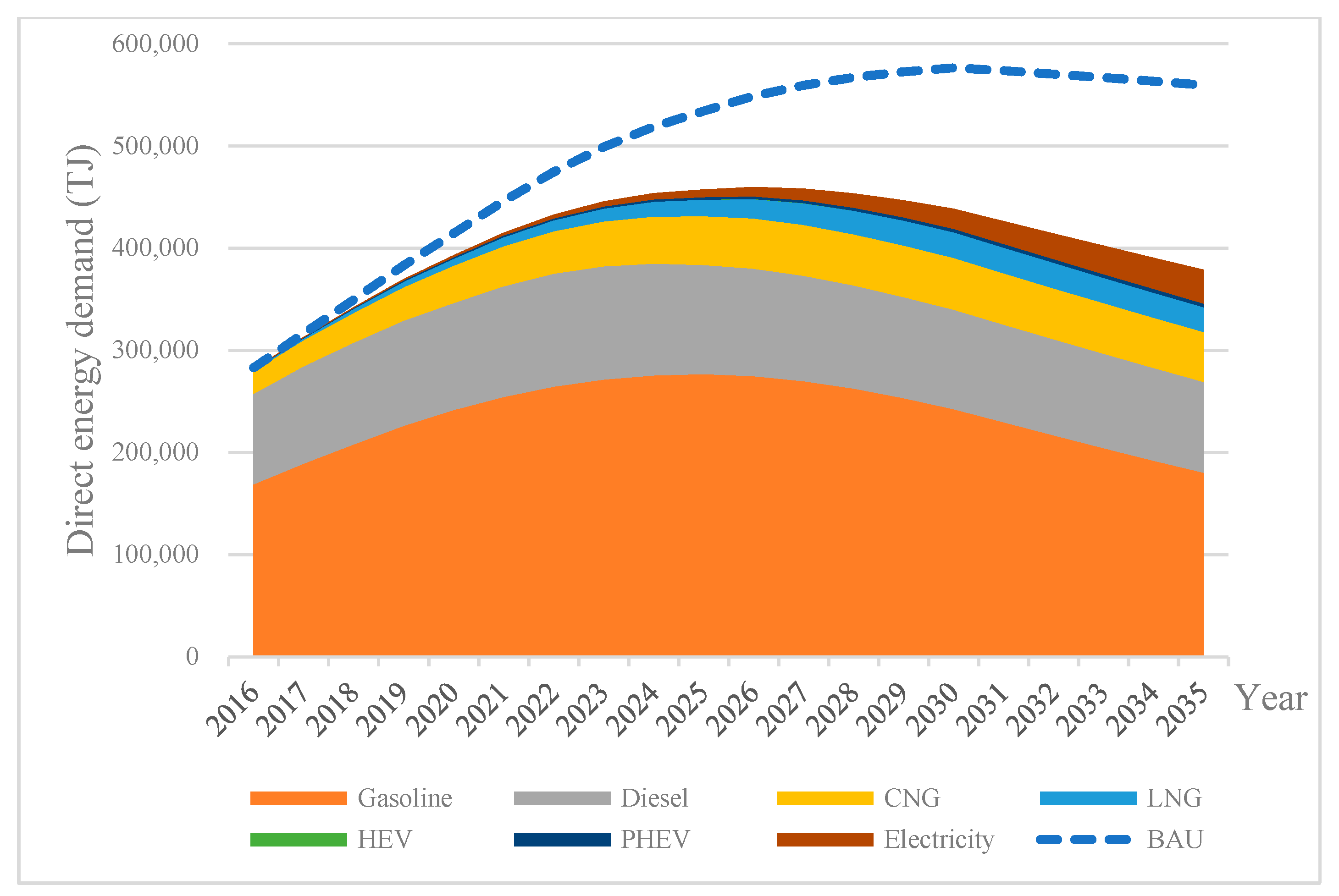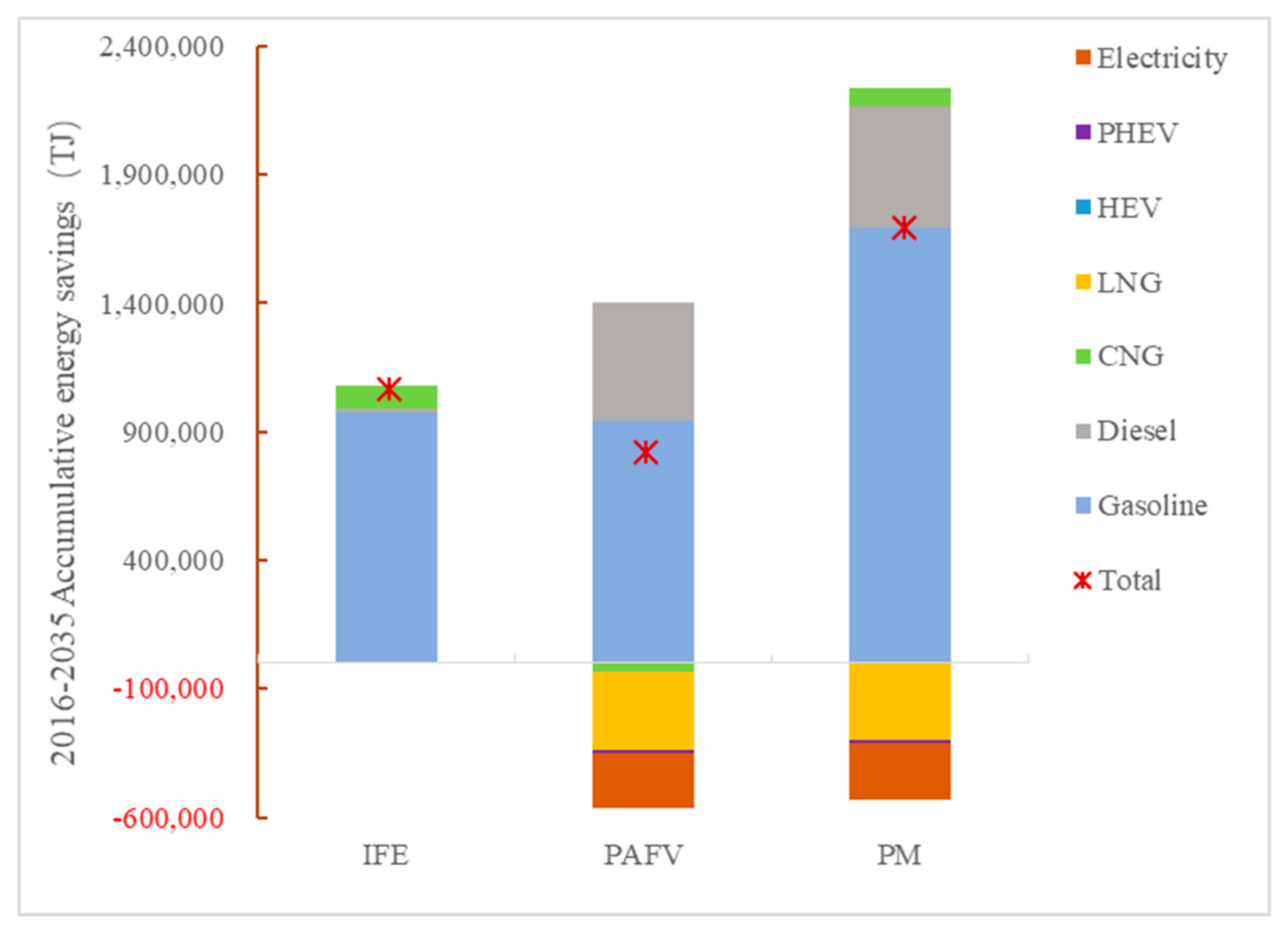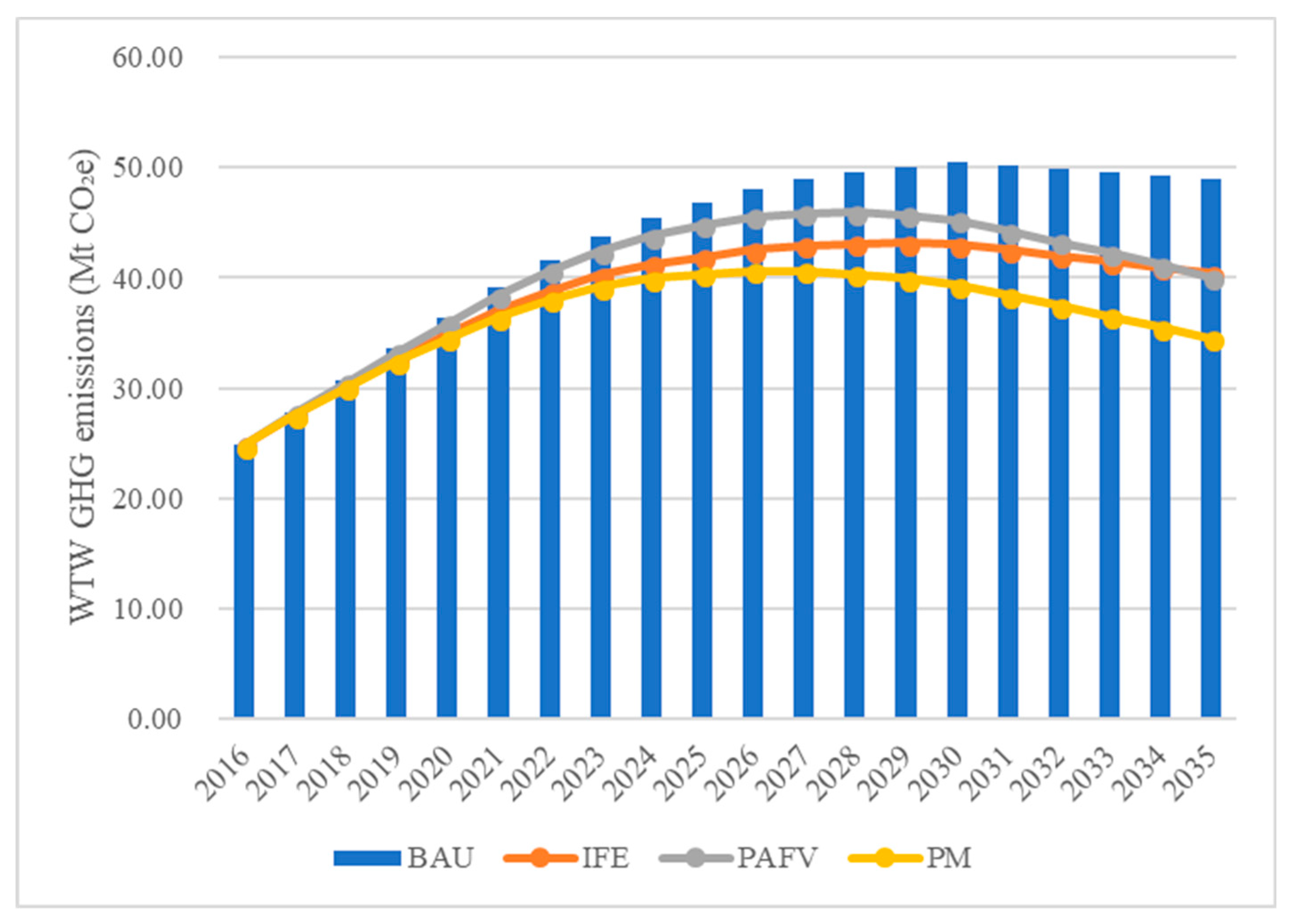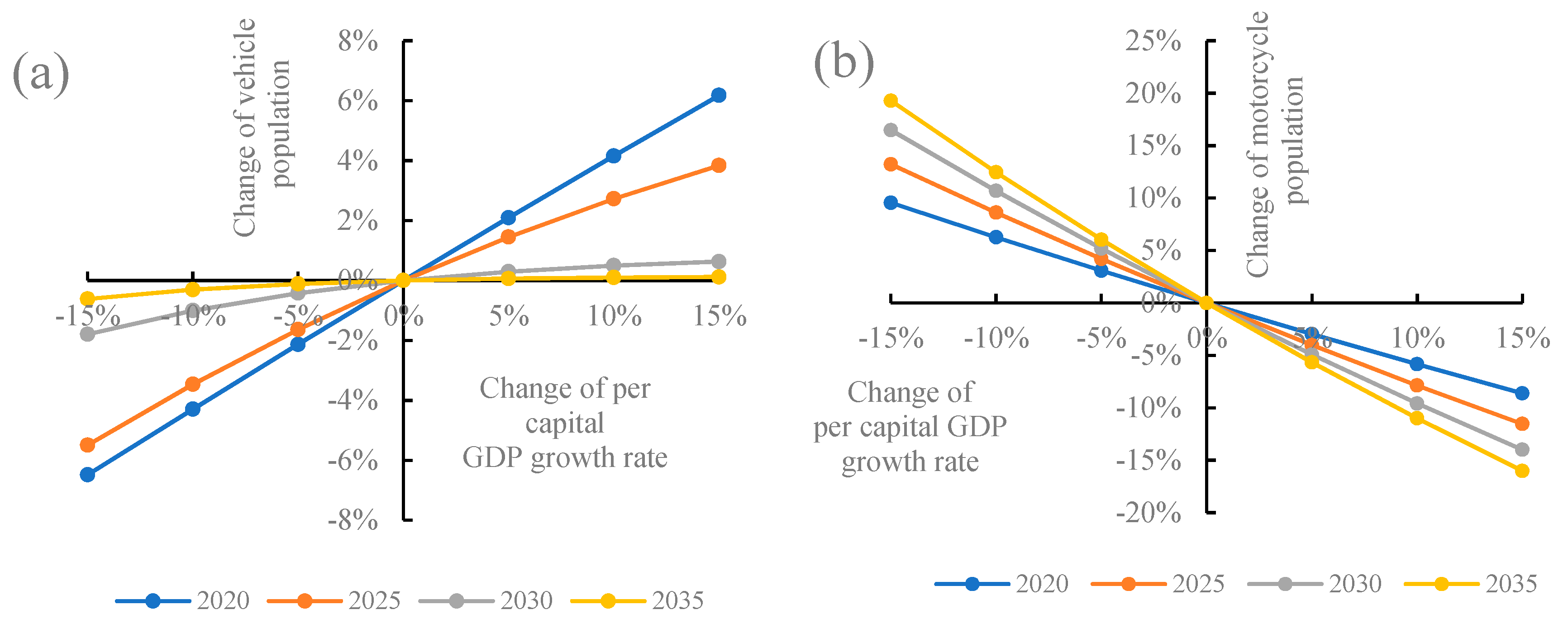1. Introduction
In 2015, the transportation sector accounted for 64.7% of global oil consumption, with road transportation accounting for 49.7% of this [
1]. To effectively control the energy consumption and greenhouse gas (GHG) emissions from road transportation, policy makers of nations and cities around the world have developed a series of integrated policy options that include mandatory standards and market-based fiscal policies with economic incentives.
The GHG emission-reduction policies of the road-transportation department can be divided into four types according to the key factors that influence the GHG emissions from vehicles: The vehicle population, fuel economy, fuel type, and kilometers travelled by vehicles (VKT). The first emission-reduction policy type involves limiting the number of motor vehicles through implementing vehicle purchase taxes [
2] and vehicle purchases via a lottery or auction of car license plates [
3,
4]. The second links to improving the fuel economy of vehicles by, for example, obsoleting cars that do not meet the emission standards set by the government, such as the implementation of the Corporate Average Fuel Economy (CAFE) standards in the USA [
5]. The third involves promoting alternative-fuel vehicles (AFVs), such as new-energy vehicles, and this policy can be implemented by, for example, promoting electric vehicles (EVs) [
6,
7,
8], compressed natural-gas (CNG) vehicles, and liquefied natural-gas (LNG) vehicles [
9,
10]. The last emission-reduction policy aims at controlling the average annual VKT of passenger cars and involves prioritizing the development of public transit systems and restricting vehicle use via plate number and public transport subsidy policies [
6,
11]. Moreover, some economic policies to reduce vehicle-use intensity (e.g., increasing parking fees and charging congestion fees in urban centers [
12,
13]) also belong to the fourth type of emission-reduction policy and they have already been implemented in some cities around the world and, yet, are currently only under discussion in China.
The analysis of road-transportation energy demands and GHG emissions, when employing different policy option implementations, has been an important research topic for both domestic and foreign scholars who have established specific models for different regions. Most of the existing studies use bottom-up models to analyze the GHG emission-reduction potential of one or more policy options from among these types of policies.
In terms of the research scope, some studies have undertaken energy-saving and GHG emission-reduction analyses on road-transportation policy options at the international and national levels. At the international level, Hoogwijk et al. [
14] employed a bottom-up approach to study the mitigation potential of low-carbon technical policy measures in three world regions (OECD, EIT, non-OECD) by focusing on the policy options related to improving fuel economy and promoting biofuels for motor vehicles. At the national level, Lutsey and Sperling [
15] carried out a bottom-up analysis on the key policies related to improving the fuel economy of vehicles and developing hybrid-powered vehicles and low-carbon fuels for the US transport sector. Moreover, Tessum et al. [
16] evaluated the impact of GHG emission-reduction policies related to passenger vehicles in the USA on air quality, GHG emission reductions, and human health, with the life cycle theory. Wang et al. [
17] used a bottom-up model to estimate the GHG emission-reduction potential of different policy scenarios for China’s road-transportation network, including engine technology improvements, transmission technology improvements, vehicle technology improvements, alternative fuels, and the development of a rapid bus transit system. He et al. [
18] predicted gasoline demand and CO
2 emissions by employing different scenarios based on a bottom-up GHG emissions’ accounting model and assessed emission reductions when improving the fuel-economy policy for various types of motor vehicles in China. Yan and Crooks [
19] used the long-range energy alternatives planning (LEAP) model to analyze China’s GHG emission-reduction potential when implementing different traffic policies, including controlling the number of private cars (PCs) in use, fuel-economy improvements, developing diesel and natural-gas vehicles, fuel tax, and promoting biofuel use. Besides the policies on improving the fuel economy of vehicles, developing diesel vehicles, and promoting alternative fuels, Huo et al. [
20] also analyzed GHG emission reductions in China in terms of the policy of developing EVs and they based their analysis on the bottom-up model. Also, taking China as the research object, Gambhir et al. [
10] adopted the previous method [
21] and conducted detailed decomposition research on the energy savings and CO
2 emission reductions for each low-carbon vehicle type.
Some other scholars have studied the GHG emission-reduction cost effectiveness of transportation polices at the regional or city level. For example, using detailed data from 48 urban areas in the USA, Hartgen et al. [
22] compared CO
2 emission reductions when improving the fuel economy of vehicles, when improving the transportation system, and when shifts in travel behavior took place. Based on this study, Moore et al. [
23] evaluated the GHG emission-reduction potential when improving fuel efficiency and signal controls, when reducing vehicle mileage, and when increasing the public transit system’s share. Based on California’s EMFAC2007 (short for EMission FACtor) model, Silva-Send et al. [
24] evaluated the GHG emission reductions for seven road-transportation policies developed by local governments in the San Diego County that will come into force by 2020. Zheng et al. [
25] and Peng et al. [
26] elaborated on the bottom-up method to the provincial level of China. He et al. [
27] improved the bottom-up method by adding influencing factors, such as the travel mode, load rate, and the population and per capita travel time to analyze the energy consumption and GHG emission-reduction effects of changes in travel modes brought about through the development of public transport and intelligent city policies.
Besides the bottom-up methods, some scholars take the Life Cycle Assessment (LCA) methods and Greenhouse gases, Regulated Emissions, and Energy use in Transportation (GREET) model to analyze the impact of low-carbon transportation policies. For example, Orsi et al. [
28] proposed an exergy-based well-to-wheels (WTW) analysis to compare different passenger vehicles, using the GREET model, based on petroleum energy use, CO
2 emissions, and economic costs in five representative national energy mixes and found no fundamental difference in the fossil fuel pathways among the five nations. Wu et al. [
29] analyzed the CO
2 emission-reduction potential of the policy promoting hybrid EVs (HEVs), plug-in HEVs (PHEVs), and pure EVs in three developed regions (Beijing-Tianjin-Hebei, the Yangtze River Delta, and the Pearl River Delta) with the GREET1.8d model combined with a scenario analysis. Zhou et al. [
30] used the LCA method to analyze the EV energy consumption and GHG emissions in different grid areas in China and they found significant differences in different regions of China due to different power structures.
There are some weaknesses in the existing literature on road-transportation energy demand and GHG emission analyses under different policy scenarios in China. First, most of the existing studies focus on the national level. As for the studies on the provinces or cities in China, most set the same policy targets when undertaking their scenario analyses for the different regions, making it difficult to reflect the differences arising from the vehicle types and fuel structures in different regions based on the different economic development levels or resource endowments. Some studies fail to consider the energy consumption and GHG emissions from motorcycles, the market share of which is quite large in some cities in China. Second, when analyzing the energy-saving and GHG emission-reduction potential of the various policy options, most studies analyze the impact of a single policy or multiple policies under their own respective policy scenarios and few studies analyze the policy interactions between different policies. Moreover, the analyses of key policy parameters lack sensitivity. In addition, due to the rapid development of China’s new-energy vehicles in recent years, the data and policy targets of the policy analyses need to be updated.
Therefore, based on our previous study [
31], this paper takes Chongqing City as an example and uses a bottom-up method, selecting two urban road-transportation low-carbon policies, improving the fuel-economy policy and promoting the development of the AFVs policy, and their mixed policy, to analyze the mechanism of energy savings and GHG emission reductions of the single policy and the mixed-policy. Thus, the main novelty of this paper is that the study incorporates a mixed-policy scenario for urban road-transportation low-carbon policies, based on the causal chain analysis method and the mechanism analysis of energy saving and GHG emission reduction of the single policy and mixed-policy, analyzes the interaction effects of different policies, and compares the evaluation results of the mixed policy with those of the individual policy-implementation scenarios. The cause of the interaction effects from the mixed-policy scenario is then discussed. Thus, the findings from this study can be used in future studies as a reference to help policy makers develop and adjust their low-carbon transportation policies for cities and regions around the world.
This study takes Chongqing City—a city in southwest China—as its case city for two reasons. First, Chongqing is one of the first low-carbon pilot provinces and cities in China, therefore, our findings can act as a low-carbon development reference for similar cities in the southwest. Second, Chongqing City, with its high level of urbanization, is experiencing rapid growth in terms of the number of motor vehicles. This has led to an increasing energy pressure, increasing carbon emissions, and more passenger cars, with PCs accounting for an increasing proportion of urban vehicles. As a result, to achieve low-carbon development, Chongqing needs to urgently undergo a low-carbon transport transformation and upgrading. In this paper, we present two hypotheses: First, in the future, road-transportation policy makers in Chongqing will actively enact low-carbon policies according to the national low-carbon development strategy and plans. Second, we assume that the economy will continue to develop rapidly in the future in Chongqing and that the level of urbanization will continue to improve: These social and economic conditions can support road transportation’s low-carbon transition in Chongqing.
4. Discussion
The process involving using models to predict the future vehicle energy consumption and GHG emissions employs the frequent use of postulates and parameter estimations, which have relatively high uncertainties. Despite the use of authoritative references to reduce these uncertainties, it is necessary to analyze uncertainties that exist in this study and that are closely related to the results of the model simulation. In this part, a few key postulates used in this research are selected for a discussion on uncertainties and an assessment of their impact.
First, this study covers an analysis of the vehicle population, VKT, growth patterns of the population, and the economy in Chongqing City; however, due to difficulties in accessing data at the city level, the fuel-economy statistics at the national level are used for calculations, which might have affected the accuracy of the estimation of the fuel consumption and GHG emissions of vehicles. To improve the accuracy of our calculations, reliable data regarding the fuel economy at the province and city levels need to be provided, which requires not only the efforts of academic institutions, but also cooperation from the respective government agencies.
Second, this study works with a scenario analysis on the future targets of road-transportation low-carbon policies, but, in fact, there will be uncertainty due to human factors during the implementation of the policies. For example, people’s travel needs and behavior changes will affect the choice in terms of their travel mode and people’s willingness to purchase—and the affordability of—new-energy vehicles will affect the actual promotion rate of new-energy vehicles. Therefore, the resolution of these uncertainties requires a more detailed investigation and study in the future.
Based on the research results above, this paper puts forward the following policy suggestions for the low-carbon development of the road-transportation sector in Chongqing and China in the future:
The national government should dominate regions to optimize power-generation energy structures. The GHG emission-reduction effect of new-energy vehicles, especially EVs, is closely related to the electricity-emission factor of the regional power grid. In China, the electricity-emission factor is still high due to the coal-dominated power-generation structure in China when compared to Europe, the USA, and other developed countries. According to the results of our analysis on the TTW and WTW GHG emissions, in the early period of implementing the promotion policy for AFVs, the effect of the WTW GHG emission-reduction policy will not be significant because of the high emission factors of the electricity. With an increase in the ratio of non-fossil energy for power generation, the electricity-emission factor will decrease and the WTW GHG reduction effect, stemming from the policy, will become significant. Therefore, the national and regional governments should continue to optimize the power-generation energy structure, while they promote EVs in the future and should promote the use of non-fossil renewable-energy power generation. As for Chongqing, we suggest that the Chongqing government should take advantage of the regional resources to vigorously develop hydropower, natural-gas power generation, and other clean energies to increase the effect of GHG emission reductions from EVs at the source.
Continue to expand natural-gas vehicle applications. Due to the abundant natural-gas resources in Chongqing, and the surrounding area of the Sichuan Province, the Chongqing government promoted the use of CNG buses and taxis early on and now their share has reached an upper limit of almost 99% at present. There are already many gas filling stations in the main urban area of Chongqing, but the fuel that current PCs use is still mainly gasoline. According to the scenario analysis promoting the AFV policy, the promotion of CNG and LNG vehicles in Chongqing will increase natural-gas energy consumption and, eventually, this will reduce the WTW GHG emissions of the road-transportation sector. In addition, the current Chongqing long-distance HDBs and HDTs still mainly use diesel as fuel. In the future, with adequate resources and sufficient funds, it is recommended that more effort could be made to promote the use of CNG and LNG in the field of PCs and heavy-duty vehicles, and to build gas stations at expressway service points and along key highways.
Develop and implement more effective fuel-economy standards. From the above analysis, we can see that the GHG emission-reduction effect of improving the fuel economy via the conventional-fuel passenger car policy is not very high in the early stage, but, with the cumulative effect of new vehicles, in the medium and long term, the WTW GHG will gradually become significant from 2020 onwards. Therefore, the Chongqing government and the Chinese central government should continue to make and implement fuel-economy standards and encourage the relevant automobile manufacturing enterprises to research and develop new technologies to improve the fuel economy through vehicle lightweight technology, reduced air-resistance technology, and so on. Moreover, a corresponding measurement assessment and reward-and-punishment system should be built so that, after specific timeframes, the fuel economy of any new vehicles from automobile manufacturing enterprises can be tested under actual road conditions.
Last, according to the results of this study, the two policies we analyzed will have a hedging effect on the direct energy consumption and GHG emission reductions, and, with improvements in vehicle fuel technology and the increasing proportion of new-energy vehicles, in the long term, the hedging effect will become more significant. Therefore, in the future, the policy makers in Chongqing or in similar cities across China might like to consider enhancing both policies and introducing or enhancing some other road-transportation policy options, such as reducing the purchase tax on motorcycles to encourage residents to buy and use more motorcycles instead of PCs and reducing bus ticket fees or increasing bus lanes to encourage residents to travel by bus to further reduce the energy consumption and GHG emissions generated by PCs. The specific GHG emission-reduction effects of these policy options can be further investigated and studied in the future.




